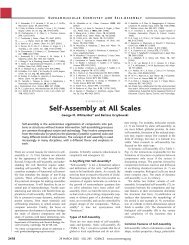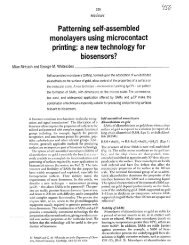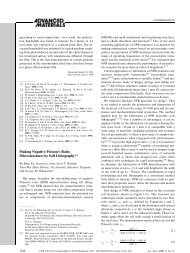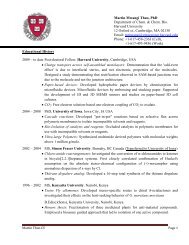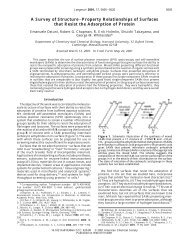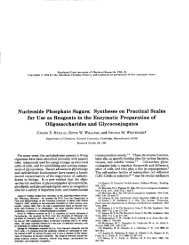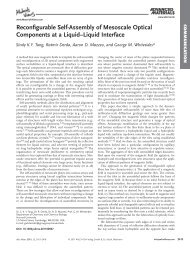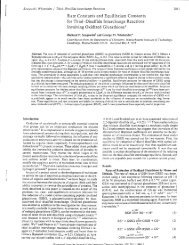Self-Assembled Monolayers of Thiolates on Metals as - Whitesides ...
Self-Assembled Monolayers of Thiolates on Metals as - Whitesides ...
Self-Assembled Monolayers of Thiolates on Metals as - Whitesides ...
Create successful ePaper yourself
Turn your PDF publications into a flip-book with our unique Google optimized e-Paper software.
1108 Chemical Reviews, 2005, Vol. 105, No. 4 Love et al.<br />
(ii) they enable other nanosystems, e.g., nanoparticles,<br />
(iii) they interact with biological nanostructuressproteins,<br />
etc., (iv) and they form patterns<br />
<strong>on</strong> surfaces with critical dimensi<strong>on</strong>s below 100 nm;<br />
(3) to outline what is not understood about these<br />
SAMs and which <str<strong>on</strong>g>of</str<strong>on</strong>g> their properties are not yet<br />
c<strong>on</strong>trolled; and (4) to sketch some <str<strong>on</strong>g>of</str<strong>on</strong>g> the important<br />
opportunities that still remain for future progress in<br />
research involving SAMs.<br />
2. Preparati<strong>on</strong> <str<strong>on</strong>g>of</str<strong>on</strong>g> SAMs<br />
The early literature <strong>on</strong> SAMs (1983-1993) focused<br />
largely <strong>on</strong> the <strong>as</strong>semblies formed by the adsorpti<strong>on</strong><br />
<str<strong>on</strong>g>of</str<strong>on</strong>g> organosulfur compounds from soluti<strong>on</strong> or the vapor<br />
ph<strong>as</strong>e <strong>on</strong>to planar metal substrates <str<strong>on</strong>g>of</str<strong>on</strong>g> gold and<br />
silver. 20,21,29,88,146-153 These studies used three types<br />
<str<strong>on</strong>g>of</str<strong>on</strong>g> organosulfur compounds: alkanethiols (HS(CH2)nX),<br />
dialkyl disulfides (X(CH2)mS-S(CH2)nX), and dialkyl<br />
sulfides (X(CH2)mS(CH2)nX), where n and m are the<br />
number <str<strong>on</strong>g>of</str<strong>on</strong>g> methylene units and X represents the end<br />
group <str<strong>on</strong>g>of</str<strong>on</strong>g> the alkyl chain (-CH3, -OH, -COOH). The<br />
experiments established many <str<strong>on</strong>g>of</str<strong>on</strong>g> the b<strong>as</strong>ic structural<br />
characteristics <str<strong>on</strong>g>of</str<strong>on</strong>g> these systems (surface structure,<br />
chain organizati<strong>on</strong>, orientati<strong>on</strong>), practical protocols<br />
for preparing SAMs (c<strong>on</strong>centrati<strong>on</strong>s, length <str<strong>on</strong>g>of</str<strong>on</strong>g> time<br />
for immersi<strong>on</strong>, solvents, temperature), and some<br />
details <str<strong>on</strong>g>of</str<strong>on</strong>g> the thermodynamics and kinetics governing<br />
the process <str<strong>on</strong>g>of</str<strong>on</strong>g> <strong>as</strong>sembly. Comprehensive reviews <str<strong>on</strong>g>of</str<strong>on</strong>g><br />
the early work are available. 22,144,154<br />
A major porti<strong>on</strong> <str<strong>on</strong>g>of</str<strong>on</strong>g> the research <strong>on</strong> SAMs since the<br />
early 1990s h<strong>as</strong> c<strong>on</strong>tinued to expand the types <str<strong>on</strong>g>of</str<strong>on</strong>g><br />
substrates used to support SAMs, and, to some<br />
degree, the types <str<strong>on</strong>g>of</str<strong>on</strong>g> molecules used to form them.<br />
Table 1 indicates, however, that the variety <str<strong>on</strong>g>of</str<strong>on</strong>g> ligands<br />
studied is still limited to functi<strong>on</strong>alities formed from<br />
a small set <str<strong>on</strong>g>of</str<strong>on</strong>g> elements in a narrow range <str<strong>on</strong>g>of</str<strong>on</strong>g> oxidati<strong>on</strong><br />
states and that much <str<strong>on</strong>g>of</str<strong>on</strong>g> the work h<strong>as</strong> c<strong>on</strong>tinued to<br />
focus <strong>on</strong> SAMs formed from thiols. Nevertheless, the<br />
p<strong>as</strong>t decade h<strong>as</strong> seen a significant expansi<strong>on</strong> in<br />
studies that exploit the <strong>as</strong>sembly <str<strong>on</strong>g>of</str<strong>on</strong>g> SAMs <strong>on</strong> nanostructures.<br />
The availability <str<strong>on</strong>g>of</str<strong>on</strong>g> new types <str<strong>on</strong>g>of</str<strong>on</strong>g> nanostructures<br />
with well-defined shapes and sizes <strong>on</strong><br />
planar supports (metal structures <strong>on</strong> silic<strong>on</strong> wafers<br />
or gl<strong>as</strong>s slides) and in soluti<strong>on</strong> (nanocrystals, templated<br />
structures) h<strong>as</strong> stimulated wide applicati<strong>on</strong><br />
<str<strong>on</strong>g>of</str<strong>on</strong>g> SAMs for stabilizing these new structures <str<strong>on</strong>g>of</str<strong>on</strong>g><br />
metallic (and other) nanoscale materials and manipulating<br />
the interfacial/surface properties <str<strong>on</strong>g>of</str<strong>on</strong>g> these<br />
materials. This secti<strong>on</strong> <str<strong>on</strong>g>of</str<strong>on</strong>g> the review describes some<br />
<str<strong>on</strong>g>of</str<strong>on</strong>g> the types <str<strong>on</strong>g>of</str<strong>on</strong>g> substrates most widely used for<br />
supporting SAMs and reviews what is known about<br />
the methods for preparing SAMs from different<br />
organosulfur compounds in soluti<strong>on</strong> and from the<br />
vapor ph<strong>as</strong>e.<br />
2.1. Types <str<strong>on</strong>g>of</str<strong>on</strong>g> Substrates<br />
The surface <strong>on</strong> which a SAM forms and the physical<br />
object supporting that surface <str<strong>on</strong>g>of</str<strong>on</strong>g>ten are referred<br />
to <strong>as</strong> the “substrate”. Types <str<strong>on</strong>g>of</str<strong>on</strong>g> substrates range from<br />
planar surfaces (gl<strong>as</strong>s or silic<strong>on</strong> slabs supporting thin<br />
films <str<strong>on</strong>g>of</str<strong>on</strong>g> metal, metal foils, single crystals) to highly<br />
curved nanostructures (colloids, nanocrystals, nanorods).<br />
Planar substrates are used widely for charac-<br />
terizing the structure-property relati<strong>on</strong>ships <str<strong>on</strong>g>of</str<strong>on</strong>g> SAMs<br />
because they are c<strong>on</strong>venient (e<strong>as</strong>y to prepare) and<br />
compatible with a number <str<strong>on</strong>g>of</str<strong>on</strong>g> techniques for surface<br />
analysis and spectroscopic/physical characterizati<strong>on</strong><br />
such <strong>as</strong> reflectance absorpti<strong>on</strong> infrared spectroscopy<br />
(RAIRS), 155,156 Raman spectroscopy, 151 X-ray photoelectr<strong>on</strong><br />
spectroscopy (XPS), 157,158 high-resoluti<strong>on</strong><br />
electr<strong>on</strong> energy loss spectroscopy (HREELS), 158 nearedge<br />
X-ray absorpti<strong>on</strong> fine structure spectroscopy<br />
(NEXAFS), 159 helium atom scattering, 160,161 X-ray<br />
diffracti<strong>on</strong>, 161,162 c<strong>on</strong>tact angle g<strong>on</strong>iometry, 154 optical<br />
ellipsometry, 21,156 surface pl<strong>as</strong>m<strong>on</strong> res<strong>on</strong>ance (SPR)<br />
spectroscopy, 156 m<strong>as</strong>s spectrometry, 163 and scanning<br />
probe microscopy (SPM). 5,153,164,165 Other metallic<br />
nanostructures, such <strong>as</strong> nanoparticles or those formed<br />
by templating, also can support SAMs, and these<br />
systems have been characterized by many techniques<br />
including electr<strong>on</strong> microscopy, 166 SPM, 167,168 edge<br />
X-ray absorpti<strong>on</strong> fine structure spectroscopy (EXAFS)<br />
and X-ray absorpti<strong>on</strong> near-edge spectroscopy<br />
(XANES), 169 infrared spectroscopy, 170,171 UV-vis spectroscopy,<br />
172 differential scanning calorimetry<br />
(DSC), 170,173 m<strong>as</strong>s spectroscopy, 174 high-pressure<br />
liquid chromatography, 175 electrochemistry (see secti<strong>on</strong><br />
9.5), 176 and NMR spectroscopy. 170<br />
The criteria important for selecting the type <str<strong>on</strong>g>of</str<strong>on</strong>g><br />
substrate and method <str<strong>on</strong>g>of</str<strong>on</strong>g> preparati<strong>on</strong> are dependent<br />
<strong>on</strong> the applicati<strong>on</strong> for which the SAM is used. For<br />
example, polycrystalline films are sufficient for many<br />
applicati<strong>on</strong>s <strong>on</strong> planar substrates such <strong>as</strong> etch resists<br />
(secti<strong>on</strong> 8.1), templates for crystallizati<strong>on</strong> (secti<strong>on</strong><br />
8.3), and model surfaces for biological studies (secti<strong>on</strong><br />
8.4) because a wide range <str<strong>on</strong>g>of</str<strong>on</strong>g> materials can be<br />
deposited e<strong>as</strong>ily and these substrates are inexpensive<br />
relative to single crystals. Other applicati<strong>on</strong>s, such<br />
<strong>as</strong> me<strong>as</strong>urements <str<strong>on</strong>g>of</str<strong>on</strong>g> electr<strong>on</strong> transport through organic<br />
molecules (secti<strong>on</strong> 8.2), benefit from substrates<br />
that are single crystals or polycrystalline films with<br />
minimal grain boundaries.<br />
2.1.1. Preparati<strong>on</strong> <str<strong>on</strong>g>of</str<strong>on</strong>g> Thin Metal Films <strong>as</strong> Substrates for<br />
SAMs<br />
The most comm<strong>on</strong> planar substrates for SAMs<br />
formed from alkanethiols are thin films <str<strong>on</strong>g>of</str<strong>on</strong>g> metal<br />
supported <strong>on</strong> silic<strong>on</strong> wafers, gl<strong>as</strong>s, mica, or pl<strong>as</strong>tic<br />
substrates. These substrates are e<strong>as</strong>y to prepare by<br />
physical vapor depositi<strong>on</strong> (PVD) methods (thermal<br />
or electr<strong>on</strong> beam (e-beam) evaporati<strong>on</strong>), 177 electrodepositi<strong>on</strong>,<br />
178 or electroless depositi<strong>on</strong>. 179-183 PVD and<br />
electrodepositi<strong>on</strong> can generate thin films <str<strong>on</strong>g>of</str<strong>on</strong>g> a wide<br />
range <str<strong>on</strong>g>of</str<strong>on</strong>g> metals (including gold, silver, copper, palladium,<br />
platinum, and nickel) and alloys.<br />
Thin Films <strong>on</strong> Gl<strong>as</strong>s or Silic<strong>on</strong> by PVD. A<br />
typical thin film deposited <strong>on</strong>to a silic<strong>on</strong> wafer or<br />
gl<strong>as</strong>s support c<strong>on</strong>sists <str<strong>on</strong>g>of</str<strong>on</strong>g> a thin primer or adhesi<strong>on</strong><br />
layer <str<strong>on</strong>g>of</str<strong>on</strong>g> titanium, chromium, or nickel (1-5 nm) and<br />
a layer <str<strong>on</strong>g>of</str<strong>on</strong>g> coinage or noble metal (10-200 nm). The<br />
primer improves the adhesi<strong>on</strong> <str<strong>on</strong>g>of</str<strong>on</strong>g> metals that do not<br />
form oxides readily (especially gold) to substrates<br />
with an oxidized surface, e.g., silic<strong>on</strong> wafers with the<br />
native oxide, and gl<strong>as</strong>s slides. Metal films <strong>on</strong> gl<strong>as</strong>s<br />
or silic<strong>on</strong> are polycrystalline and composed <str<strong>on</strong>g>of</str<strong>on</strong>g> a<br />
c<strong>on</strong>tinuous layer <str<strong>on</strong>g>of</str<strong>on</strong>g> c<strong>on</strong>tiguous islands or grains <str<strong>on</strong>g>of</str<strong>on</strong>g><br />
metal that can range in size from ∼10 to 1000 nm




